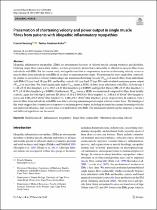| dc.contributor.author | Henning, Franclo | |
| dc.contributor.author | Kohn, Tertius Abraham | |
| dc.date.accessioned | 2023-03-17T09:11:00Z | |
| dc.date.available | 2023-03-17T09:11:00Z | |
| dc.date.issued | 2022 | |
| dc.identifier.citation | Henning, F., & Kohn, T. A. (2022). Preservation of shortening velocity and power output in single muscle fibres from patients with idiopathic inflammatory myopathies. Journal of Muscle Research and Cell Motility, 43(4). https://doi.org/10.1007/s10974-022-09638-w | en_US |
| dc.identifier.issn | 1573-2657 | |
| dc.identifier.uri | https://doi.org/10.1007/s10974-022-09638-w | |
| dc.identifier.uri | http://hdl.handle.net/10566/8616 | |
| dc.description.abstract | Idiopathic inflammatory myopathies (IIMs) are autoimmune disorders of skeletal muscle causing weakness and disability.
Utilizing single fibre contractility studies, we have previously shown that contractility is affected in muscle fibres from
individuals with IIMs. For the current study, we hypothesized that a compensatory increase in shortening velocity occurs in
muscle fibres from individuals with IIMs in an effort to maintain power output. We performed in vitro single fibre contractility
studies to assess force–velocity relationships and maximum shortening velocity (
Vmax) of muscle fibres from individuals
with IIMs (25 type I and 58 type IIA) and healthy controls (66 type I and 27 type IIA) and calculated maximum power output
(
Wmax) for each fibre. We found significantly higher Vmax
(mean ± SEM) of fibres from individuals with IIMs, for both type I
(1.40 ± 0.31 fibre lengths/s, n = vs. 0.63 ± 0.13 fibre lengths/s; p = 0.0019) and type IIA fibres (2.00 ± 0.17 fibre lengths/s vs
0.77 ± 0.10 fibre lengths/s; p < 0.0001). Furthermore, Wmax
(mean ± SEM) was maintained compared to fibres from healthy
controls, again for both type I and type IIA fibres (4.10 ± 1.00 kN/m2·fibre lengths/s vs. 2.00 ± 0.16 kN/m2·fibre lengths/s;
p = ns and 9.00 ± 0.64 kN/m2·fibre lengths/s vs. 6.00 ± 0.67 kN/m2·fibre lengths/s; p = ns respectively). In addition, type I
muscle fibres from individuals with IIMs was able to develop maximum power output at lower relative force. The findings of
this study suggest that compensatory responses to maintain power output, including increased maximum shortening velocity
and improved efficiency, may occur in muscle of individuals with IIMs. The mechanism underlying this response is unclear,
and different hypotheses are discussed. | en_US |
| dc.language.iso | en | en_US |
| dc.publisher | Springer | en_US |
| dc.subject | Skeletal muscle | en_US |
| dc.subject | Bioscience | en_US |
| dc.subject | Inflammatory myopathies | en_US |
| dc.subject | Fibre | en_US |
| dc.subject | Disability | en_US |
| dc.title | Preservation of shortening velocity and power output in single muscle fibres from patients with idiopathic inflammatory myopathies | en_US |
| dc.type | Article | en_US |

